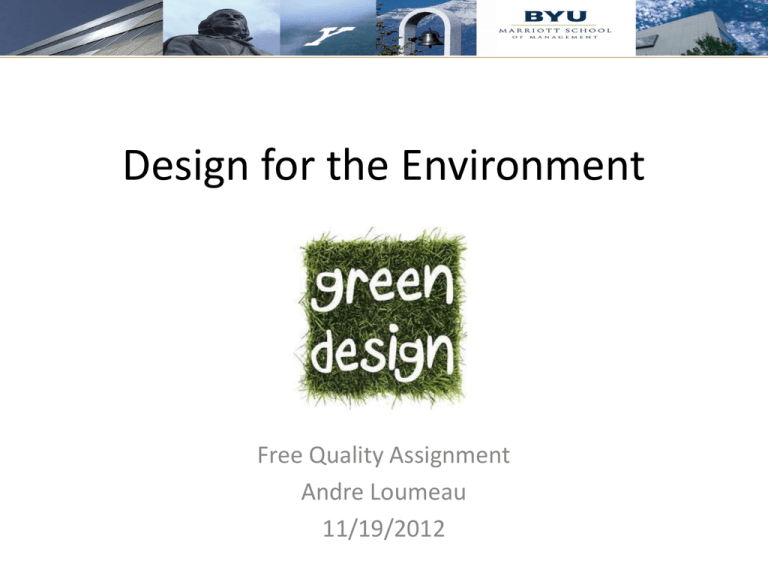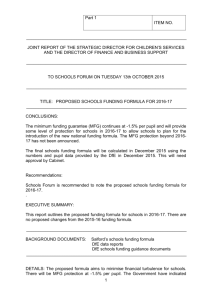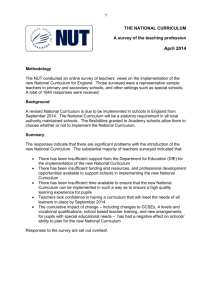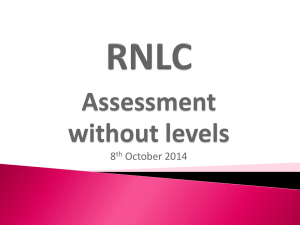Design for the Environment
advertisement

Design for the Environment Free Quality Assignment Andre Loumeau 11/19/2012 Outline • What is design for the environment? • How can it be applied to your organization? • What are the nuts and bolts of “green design” and how does it work exactly? • Company DfE Programs • Hewlett Packard – A Real World Example • A mental Exercise to help you think about the environmental impacts of products 11/19/2012 Design for the Environment 2 What is DfE? • Design for the environment the process of designing the entire life cycle of a product or service so that at each phase of its life it is creating the smallest detrimental effect possible on overall human health and the environment as a whole 11/19/2012 Design for the Environment 3 Brainstorming Exercise • How can this tool be used in your organization? • Choose a product or service that you are familiar with • Write down the basic life cycle stages including procurement, manufacture, packaging, and disposal • Pick one of the four life-cycle stages • Write down a list of five possible ways to improve • Estimate the environmental and financial impact of each possible solution you have suggested 11/19/2012 Design for the Environment 4 Example 11/19/2012 Design for the Environment 5 DfE at each Stage in Life Cycle Procurement End-of-Life Manufacture Packaging 11/19/2012 Design for the Environment 6 Designing the procurement process • Standards are available in most countries • The key is to be as transparent as possible in how you procure your raw materials or input parts • Managing supplier relationships is becoming increasing important • Example: Casio 11/19/2012 Design for the Environment 7 Green Procurement - Casio 11/19/2012 Design for the Environment 8 Designing the manufacture process • • • • • Digital Prototyping of both product and workflow Energy Efficiency Materials Analysis Lean Manufacturing The Five S’s 11/19/2012 Design for the Environment 9 Designing the packaging process • Use recycled materials • Eliminate or reduce hazardous substances from packaging materials • Use as few packaging materials as possible • Use materials that can be recycled in the future • Create awareness among consumers • Use materials of greener origins 11/19/2012 Design for the Environment 10 Designing the end-of-life process • • • • Design for reuse Design for disassembly Design for remanufacture Sell to other companies who can reuse or remanufacture specific parts • Proper disposal of waste 11/19/2012 Design for the Environment 11 Company DfE Programs • Harmful effects of greenhouse gases and waste materials are now known • Consumers are demanding greener products • Companies have responded by creating their own DfE programs • As programs have proven beneficial to the bottom line, more and more companies are adopting them 11/19/2012 Design for the Environment 12 Creating a DfE program • There are many ways to create a DfE program but the following general guidelines give a good starting point: • Assign product stewards • Product stewards and product designers work together and submit regular reports • Reports should identify, prioritize, and recommend environmental improvements 11/19/2012 Design for the Environment 13 Creating a DfE program • Upper management decides which changes in the product life cycle will have the greatest impact • Upper management assesses how these initiatives jive with the core competencies and resources available to find the best plan of action • Upper management publishes a list of priorities and principle measures that are being taken to achieve those priority goals 11/19/2012 Design for the Environment 14 A Real World Example 11/19/2012 Design for the Environment 15 HP’s DfE Program • Created in 1992 • Product stewards and designers work together on each project to achieve vision • Three major priorities: – Energy efficiency – Materials innovation – Design for recyclability 11/19/2012 Design for the Environment 16 HP’s DfE Program • Main initiatives implemented to achieve priorities: • Eliminating the use of harmful flame retardants • Reducing number of parts used and standardizing parts for multiple products • Using mold-in colors and finishes as opposed to paint and coatings • Helping customers reduce energy consumption through using HP products 11/19/2012 Design for the Environment 17 HP’s DfE Program • Increase the use of recycled materials in products • Minimizing waste through reducing amount of packaging materials • Designing for disassembly and recyclability through using less parts and implementing ISO 11469 11/19/2012 Design for the Environment 18 Results of HP’s DfE Program • Last year, HP took back 140 million pounds of end-oflife HP products and either reused them or properly disposed of them • HP better understands how customers use their products • HP has seen a big positive impact on their bottom line • Energy efficiency is now second nature to HP employees 11/19/2012 Design for the Environment 19 A Mental Exercise • You own a restaurant and you are trying to decide whether paper napkins or cloth napkins have less of an effect on the environment • Write down on a piece of paper all of the possible effects that each type of napkin could have on the environment at each stage of its product life cycle 11/19/2012 Design for the Environment 20 A Mental Exercise • What did you come up with? • What are the procurement and manufacturing effects of each? • What about washing and drying the napkins? • Disposal or reuse? 11/19/2012 Design for the Environment 21 Summary • DfE is about being a good steward of your company’s impact on the environment and the general public health • At each stage of the product life cycle, initiatives can be set to reduce negative impacts on the environment • Your company can establish its own DfE program to protect the environment, improve public perception, and help the bottom line 11/19/2012 Design for the Environment 22 Readings List • Design and Environment: A Global Guide to Designing Greener Goods by Helen Lewis and John Gertsakis • Cradle to Cradle: Remaking the Way We Make Things by Michael Braungart • Sustainable by Design: Explorations in Theory and Practice by Stuart Walker • ecoDesign: The Sourcebook by Alastair Fuad-Luke • The Green to Gold Business Playbook: How to Implement Sustainability Practices for Bottom-Line Results in Every Business Function by Daniel C. Esty • What is Lean Six Sigma by Michael L. George 11/19/2012 Design for the Environment 23




